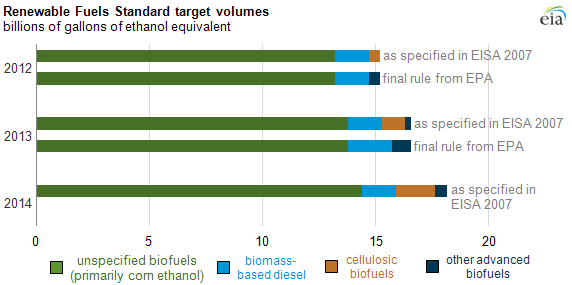
EPA finalizes Renewable Fuel Standard for 2013; additional adjustments expected in 2014

Republished August 14, 2013, 10:28 a.m. to add a link.
The Environmental Protection Agency (EPA) last week issued its final rule for the 2013 Renewable Fuel Standard (RFS) program year. The rule sets a 6 million gallon target for cellulosic biofuels use in 2013, less than half the level in the proposed rule issued in February 2013, and far below the 1 billion gallon target specified in the Energy Independence and Security Act of 2007 (EISA 2007).
By law, EPA can lower the required volumes of advanced biofuels and total renewable fuels by up to the amount that it reduces the required volume of cellulosic biofuels. EPA chose not to reduce the advanced biofuels and total renewable fuels targets for 2013, leaving the required volume of total renewable fuels in 2013 at the 16.55 billion gallons specified in EISA 2007. However, the final rule states that EPA anticipates the need to adjust those targets for the 2014 RFS program year, for which EISA 2007 specifies a total renewable fuels target of 18.15 billion gallons. EPA's forthcoming notice of proposed rulemaking for the 2014 RFS program year will provide further information.
As discussed in previous TIE articles, a May 2013 letter from EIA cited in EPA's final RFS rule, and recent testimony by EIA Administrator Adam Sieminski, production of cellulosic biofuels has grown at a much slower pace than envisioned in EISA 2007. The RFS consists of four nested volumetric targets for specific types of biofuels. By 2022, EISA 2007 specifies a 36 billion gallon target for total renewable fuels in transportation fuel, including 21 billion gallons of advanced biofuels, of which 16 billion gallons are cellulosic biofuels.
Beyond delays in the ramp-up of cellulosic biofuels production, RFS implementation has recently been challenged by the decline in recent and projected gasoline consumption since enactment of EISA 2007, reflecting higher vehicle fuel economy standards, slower economic growth, higher gasoline prices, and possible changes in consumer behavior. The level of gasoline consumption limits the amount of ethanol that may be used in the gasoline pool at any fixed blending level, such as the 10% ethanol blend (E10) that is predominant in the current U.S. gasoline supply. The anticipated need for adjustments in the 2014 RFS advanced biofuels and total renewable fuels targets reflects a combination of demand and supply issues in the biofuels marketplace, including
- The E10 blend wall in the context of stagnant or declining demand for petroleum-based gasoline
- The limited ability of the motor gasoline market in the United States to consume ethanol in higher blends such as E15 and E85, which are constrained as a result of infrastructure- and market-related factors
- The difficulty of producing significant volumes of non-ethanol advanced biofuels fuels such as biodiesel, renewable diesel, and biogas
Lacking foresight into EPA's future RFS rules, EIA has needed to make explicit assumptions about RFS targets for 2014 in developing its monthly Short-Term Energy Outlook (STEO), which from the start of 2013 included forecasts through December 2014. Starting with the February 2013 edition, the STEO has assumed that 2014 RFS targets for advanced and total biofuels would be held at their then-proposed, now-final 2013 levels. The forthcoming EPA proposal for the 2014 RFS rule, and the subsequent final rule, have the potential to affect EIA's forecast of volumes and prices for motor fuels markets next year. Like many others, EIA will be closely monitoring the RFS rulemaking process and other developments that have the potential to affect motor fuel markets.
The 2013 final RFS volumetric targets and RVO percent standards are as follows:
Renewable Fuel Category |
2013 RFS Volumes (billion gallons ethanol equivalent) |
2013 RVO Percent Standards |
|||
|---|---|---|---|---|---|
| Statutory | Final | ||||
| Cellulosic biofuels | 1.0 | 0.006 | 0.004% | ||
| Biomass-based diesel | 1.5* | 1.92 | 1.13% | ||
| Advanced biofuels | 2.75 | 2.75 | 1.62% | ||
| Total | 16.55 | 16.55 | 9.74% | ||
|
Source: U.S. Environmental Protection Agency, 2013 Renewable Fuel Standards Final Rule, August 6, 2013
Note: In addition to the three categories listed, the use of conventional biofuels (primarily corn ethanol) can contribute to the total renewable fuels target. * EISA 2007 sets a floor of 1.0 billion gallons for the biomass-based diesel target after 2012, equal to 1.5 billion ethanol equivalent gallons. | |||||